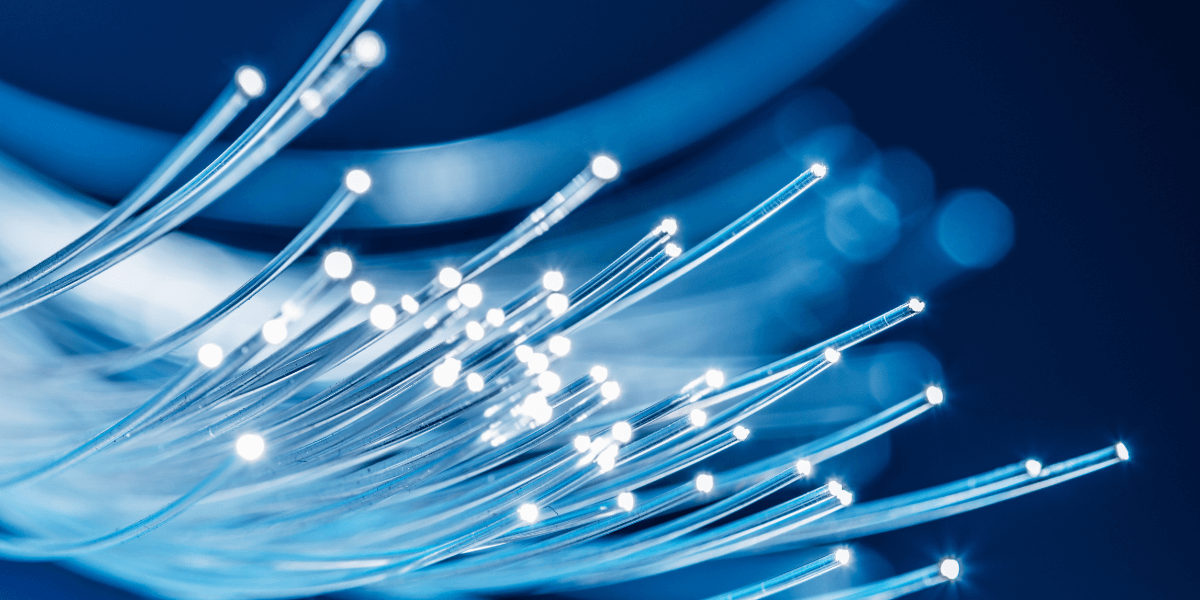The Long-Term Economic Benefits of Fiber Optic Internet

Table of Contents
Fiber optic internet is the game-changing technology revolutionizing businesses’ operations in the modern-day, internet-heavy world. Unlike traditional copper-based systems that have served us for decades, fiber optic cables transmit data using pulses of light, resulting in speeds that were once thought impossible.
But the economic benefits of fiber go far beyond faster internet. Ready to discover how this cutting-edge technology can transform your business and deliver lasting economic benefits?

Blazing Speed and Bandwidth
The Foundation of Modern Business
Understanding the Speed Revolution
We enter a completely different league than traditional copper connections when discussing fiber optic internet speed. How different? Try 10 to 100 times faster. While copper-based connections might offer download speeds of 100 Mbps on a good day, fiber consistently delivers 1,000 Mbps (1 Gbps) or more.
This isn’t just about bragging rights. This speed differential translates directly into productivity gains and economic benefits.
With fiber optic internet, your team can download massive files in seconds instead of minutes or hours. A 10GB video file that might take over 13 minutes to download on a 100 Mbps connection downloads in just 80 seconds on a 1 Gbps fiber connection. Multiply these time savings across your entire workforce, day after day, and the productivity boost becomes substantial.
Bandwidth That Grows With Your Needs
Perhaps even more valuable than raw speed is bandwidth—the capacity to handle multiple data-heavy operations simultaneously without slowdowns. Traditional internet connections often force businesses to ration their bandwidth, creating bottlenecks during peak usage times.
Fiber optic internet eliminates this constraint. With virtually unlimited bandwidth, your entire team can engage in video conferencing, cloud computing, file sharing, and streaming simultaneously without affecting performance.
This bandwidth abundance means no more scheduling your important video calls around your colleague’s file uploads. It means your customer service team can access cloud-based CRM systems instantly while your design team transfers large graphic files. The result? Seamless operations that drive efficiency and ultimately boost your bottom line.
Impact on Daily Operations
The impact of fiber’s speed and bandwidth extends to virtually every aspect of modern business operations:
- Video conferencing becomes crystal clear: No more frozen screens, choppy audio, or disconnections during crucial meetings.
- Cloud applications respond instantly: Access your cloud-based productivity tools, CRM systems, and data storage without frustrating delays.
- Remote work becomes truly viable: Support your distributed workforce with connections that make remote employees feel like they’re in the office.
- Customer interactions improve: Faster processing of customer data and smoother digital experiences lead to higher satisfaction rates.
These improvements aren’t just conveniences—they’re competitive advantages that directly affect your company’s ability to serve customers, close deals, and operate efficiently.

Short-term investment, long-term savings
The Cost Equation
Beyond the Initial Price Tag
Let’s address the elephant in the room: fiber optic internet typically requires a higher upfront investment than traditional copper-based connections. However, focusing solely on installation costs ignores the complete economic picture.
The true cost of internet connectivity encompasses not only the monthly bill but also the hidden expenses of downtime, maintenance, and lost productivity. When viewed through this lens, fiber optic internet often proves to be the more economical choice over time.
Reliability That Pays For Itself
Fiber optic cables are inherently more reliable than copper alternatives for several key reasons:
- Resistance to environmental factors: Fiber isn’t affected by electromagnetic interference, weather conditions, or electrical surges that regularly disrupt copper connections.
- Physical durability: Modern fiber optic cables can withstand significant pressure and are less prone to damage.
- Lower maintenance requirements: The physical properties of glass fiber mean fewer degradation issues over time.
This reliability translates directly into reduced downtime. Even a modest reduction in outages can save tens of thousands of dollars annually.
Energy Efficiency Creates Ongoing Savings
Fiber optic technology is remarkably energy-efficient, as it transmits data over longer distances without requiring signal boosters or additional power. This efficiency can lead to 10-20% reductions in energy costs compared to maintaining copper-based network infrastructure.
For businesses with extensive networking needs, these energy savings accumulate significantly over time, contributing to both economic benefits and sustainability goals.
Maintenance Costs Plummet
The durability of fiber optic cables dramatically reduces maintenance needs. While copper networks typically require maintenance every 2-3 years, fiber optic infrastructure can often go 5-10 years without significant maintenance costs.
For businesses, this means fewer service calls, fewer emergency repairs, and less frequent replacement of network components—all of which contribute to a lower total cost of ownership.
Scalability and Future-Proofing
The most compelling economic argument for fiber optic internet is its unparalleled scalability. Traditional networks often require complete overhauls when businesses outgrow their capacity. In contrast, fiber optic infrastructure can accommodate massive increases in data needs without requiring the replacement of physical cables.
This scalability comes from fiber’s inherent design. The same fiber cable that delivers 1 Gbps today can potentially deliver 10, 40, or even 100 Gbps in the future with only equipment upgrades at the endpoints. This means your initial investment continues to deliver value even as your data needs multiply.
Staying Ahead of the Technology Curve
The business applications of tomorrow will demand bandwidth that today’s copper infrastructure simply cannot provide. Consider these emerging technologies:
- Artificial Intelligence applications requiring real-time data processing
- Internet of Things (IoT) ecosystems connecting hundreds of devices
- Virtual and augmented reality tools for training and customer experiences
- 8K video streaming for enhanced marketing and presentations
Businesses without fiber infrastructure will struggle to adopt these technologies as they become mainstream, potentially losing a competitive advantage in their industries.
Adapting to Changing Work Models
The pandemic accelerated the shift toward hybrid and remote work models, a trend that shows no signs of reversing. Fiber optic internet provides the reliable, high-speed connectivity these distributed work environments require.
By investing in fiber now, businesses create the flexible infrastructure needed to adapt to evolving work patterns, supporting everything from video-intensive collaboration to secure access to company resources from anywhere.

Enhanced security
Protecting Your Most Valuable Asset
Physical Security Advantages
Data security isn’t just about software—it starts with the physical transmission of information. Fiber optic cables offer security advantages that impact your bottom line:
- Virtually impossible to tap: Unlike copper cables, which can be tapped to intercept data without detection, fiber optic lines are extremely difficult to tap without causing noticeable service interruptions.
- No electromagnetic radiation: Fiber doesn’t emit electromagnetic signals that can be intercepted remotely, eliminating a major vulnerability of copper networks.
For businesses handling sensitive customer information, intellectual property, or financial data, these security features reduce the risk of costly data breaches.
Regulatory Compliance Made Easier
Many industries face strict data protection regulations, including HIPAA in healthcare, PCI DSS for payment processing, and GDPR for businesses serving European customers. The enhanced security of fiber optic networks helps businesses meet these compliance requirements more effectively.
Competitive Advantage and Business Growth
Customer patience for slow websites or glitchy online services has disappeared.
Fiber optic internet ensures your digital presence operates at peak performance:
- Websites load instantly
- Online transactions process smoothly
- Digital content streams without buffering
- Customer service platforms respond immediately
These performance improvements directly impact customer satisfaction, retention, and ultimately your revenue.
Enabling Innovation and New Revenue Streams
The massive capacity of fiber enables businesses to explore new service offerings and revenue streams that would be impossible with traditional connectivity:
- High-definition telehealth services for healthcare providers
- Real-time collaborative platforms for professional services
- Interactive customer experiences for retail and hospitality
- Virtual reality showrooms for real estate and automotive industries
These innovations aren’t just about staying current—they represent opportunities to differentiate your business and capture market share from competitors still constrained by limited connectivity.
Community and Property Value Benefits
Attracting Top Talent
For businesses competing for skilled workers, office locations with fiber connectivity have become a distinct advantage. Today’s professionals increasingly expect high-performance internet as a baseline workplace amenity, particularly as hybrid work models become the norm.
Companies operating in fiber-connected facilities report greater success in recruiting technology workers and digital natives who prioritize seamless connectivity in their work environment.
Enhancing Property Values
For businesses that own their facilities, fiber connectivity represents a valuable property improvement. Commercial properties with fiber access command premium valuations. This appreciation creates real economic value beyond the operational benefits, improving your company’s asset position and potential borrowing capacity.
Contributing to Community Development
When businesses invest in fiber infrastructure, they often become catalysts for broader community connectivity. This creates positive externalities, including:
- Improved educational opportunities
- Enhanced healthcare access
- Greater economic development
- Reduced digital divide
These community benefits foster goodwill and strengthen the local talent pool, generating indirect yet meaningful economic benefits for forward-thinking companies.
Making the Switch
Before transitioning to fiber, conduct a thorough assessment of your current connectivity and future needs:
- Document current bandwidth usage patterns
- Identify bottlenecks and pain points
- Project future data needs based on growth plans
- Calculate the cost of current downtime and performance issues
This evaluation provides the baseline for measuring the return on investment (ROI) of your fiber investment.
Planning for Minimal Disruption
A well-executed transition to fiber minimizes business disruption. Consider:
- Phased implementation approaches
- Temporary hybrid setups during transition
- Weekend or after-hours installation windows
- Clear communication with staff about transition timelines
Working with experienced fiber providers helps ensure smooth implementation with minimal impact on daily operations.
Leveraging Available Incentives
Many regions offer incentives for businesses upgrading to fiber infrastructure:
- Tax credits for technology investments
- Grants for digital infrastructure improvements
- Economic development incentives
- Broadband expansion programs
These programs can significantly reduce the upfront costs of fiber implementation, improving your ROI timeline.
Don’t Get Left Behind
Connectivity isn’t just a utility—it’s the lifeblood of business operations. Companies that invest in fiber optic internet gain a foundation for growth, innovation, and competitive advantage that delivers economic benefits year after year.
The question isn’t whether your business can afford fiber optic internet. Given the productivity gains, cost savings, and future-proofing benefits, the real question is: Can you afford to wait?
While your competitors struggle with connectivity issues and infrastructure limitations, fiber connectivity lets you focus on what matters most—serving customers, innovating in your industry, and growing your business.
The economic benefits of fiber optic internet extend far beyond faster downloads. They touch every aspect of your operations, from daily productivity to strategic growth opportunities. In a business landscape where digital capability increasingly determines success, fiber provides the infrastructure advantage that keeps you ahead of the curve.
Find Out if Fidium Fiber Is Available in Your Area
Ready to experience the economic benefits of lightning-fast fiber internet for your business? Fidium Fiber is expanding rapidly across the country, bringing world-class connectivity to more communities every day.
Don’t wait to transform your business with the power of fiber. Enter your zip code here to check if Fidium Fiber is available at your location. In just seconds, you’ll discover whether you can start enjoying the unmatched speed, reliability, and economic advantages of fiber optic internet.
Sources
[1] Sonar.software. “Economic and Long-Term Benefits of Fiber Optic Infrastructure"
[2] Williamsonsource.com. “The Economic Impact of Fiber Internet on Local Businesses"
